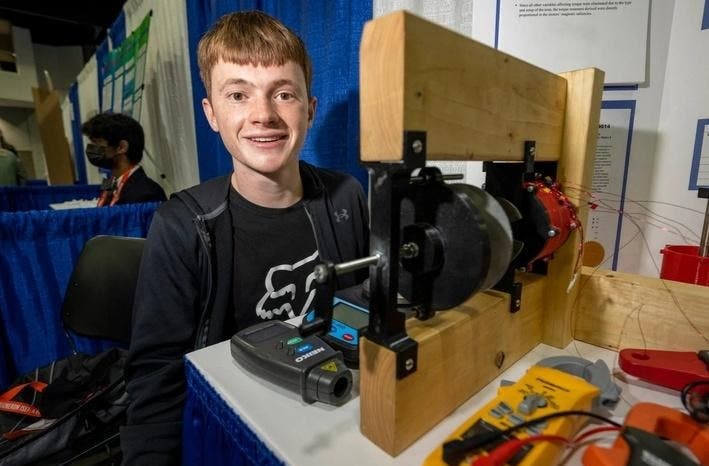17-year-old develops award-winning, environmentally-friendly, electric motor
Robert Sansone’s research could pave the way for the sustainable manufacturing of electric vehicles that do not require rare-earth magnets.

[June 18, 2023: Staff Writer, The Brighter Side of News]
Robert Sansone’s research could pave the way for the sustainable manufacturing of electric vehicles that do not require rare-earth magnets. (CREDIT: Society for Science)
17 year old, Robert Sansone, was born to be an engineer. The Fort Pierce, Florida-based inventor estimates he's completed at least 60 engineering projects in his spare time, ranging from animatronic hands to high-speed running boots. However, it's his latest project that could be vital to our future.
A couple years ago, Sansone came across a video about the advantages and disadvantages of electric cars. As explained in the video, rare-earth magnets are required for most electric car motors, and their extraction is both environmentally and financially damaging. A kilogram of rare-earth material can cost hundreds of dollars. Copper, on the other hand, is worth $7.83 per kilogram.
“I have a natural interest in electric motors. With that sustainability issue, I wanted to tackle it, and try and design a different motor", Sansone told reporters.
A type of electric motor known as a synchronous reluctance motor does not use these rare earth materials. However, these motors are currently used in pumps and fans, and they aren't powerful enough to power electric vehicles. Sansone began to search for a solution to this problem.
Related Stories
Heath Hofmann, a professor of electrical and computer engineering at the University of Michigan, says permanent magnet motors use materials such as neodymium, samarium, and dysprosium, which are highly sought after because they are used in many different products, including headphones and earbuds. A leading expert on electric vehicles, Hofmann collaborated with Tesla on its propulsion drive control algorithms.
“The number of applications that use magnets just seems to be getting larger and larger,” he says. “A lot of the materials are mined in China, and so the price can often depend upon our trade status with China.” Hofmann adds that Tesla recently started using permanent magnets in its motors.
Over the course of a year, Sansone created a novel prototype of a synchronous reluctance motor that had superior rotational force or torque and efficiency than existing ones. The motor took 15 attempts to get to its current state. Innovations in printed plastic, copper wires, and a steel rotors helped get the project over the finish line.
Sansone’s novel motor outperformed a similarly-designed traditional synchronous reluctance motor in tests of torque and efficiency. (CREDIT: Robert Sansone)
What he measured was remarkable. The new design generated 40% more torque and was far more efficient than existing electric motors. At 300 revolutions per minute (RPM), his motor had 39% greater torque and 31 percent greater efficiency. Its efficiency increased by 37% at 750 RPM.
Sansone’s entire experimental setup. (CREDIT: Robert Sansone)
In comparison, Tesla’s Model S motor can reach 18,000 RPM, explained Tesla’s principal motor designer Konstantinos Laskaris in a 2016 interview with Christian Ruoff of the electric vehicles magazine Charged.
In a repeat experiment, Sansone validated his results, in which he “isolated the theoretical principle under which the novel design creates magnetic saliency”. By eliminating all other variables, this second experiment confirmed that the improvements in torque and efficiency were correlated with the greater saliency ratio of his design.
“He's definitely looking at things the right way,” Hofmann says of Sansone. “There's the potential that it could be the next big thing.” Though, he adds that many professors work on research their whole lives, and it’s “fairly rare that they end up taking over the world.”
As validation, during this year's Regeneron International Science and Engineering Fair (ISEF), the largest international STEM competition for high schools, Sansone won first prize and $75,000 for his electric motor design.
As a rising senior at Fort Pierce Central High School, Sansone has dreams of attending the Massachusetts Institute of Technology. His winnings from ISEF will go toward college tuition.
At present, Sansone does not intend to approach any car companies until after his next phase of testing, but he hopes that one day his motor will be the choice of electric vehicles.
For more environmental news stories check out our Green Impact section at The Brighter Side of News.
Note: Materials provided above by The Brighter Side of News. Content may be edited for style and length.
Like these kind of feel good stories? Get the Brighter Side of News' newsletter.
Joseph Shavit
Head Science News Writer | Communicating Innovation & Discovery
Based in Los Angeles, Joseph Shavit is an accomplished science journalist, head science news writer and co-founder at The Brighter Side of News, where he translates cutting-edge discoveries into compelling stories for a broad audience. With a strong background spanning science, business, product management, media leadership, and entrepreneurship, Joseph brings a unique perspective to science communication. His expertise allows him to uncover the intersection of technological advancements and market potential, shedding light on how groundbreaking research evolves into transformative products and industries.



